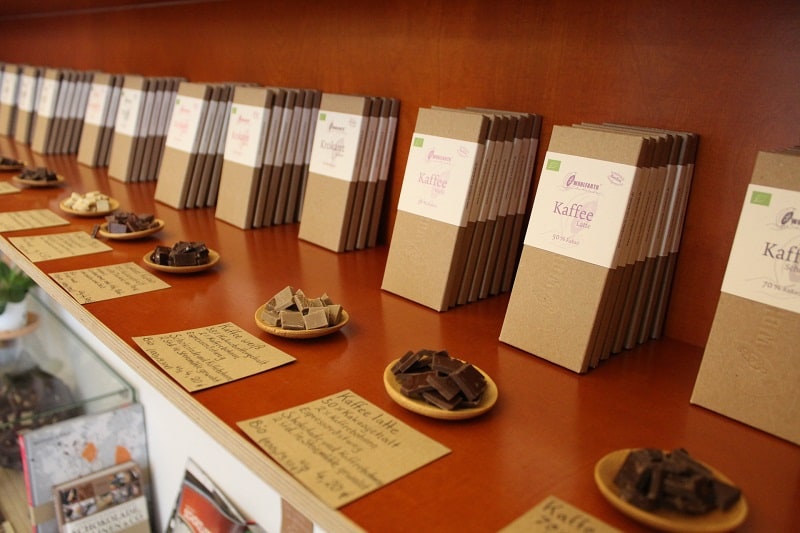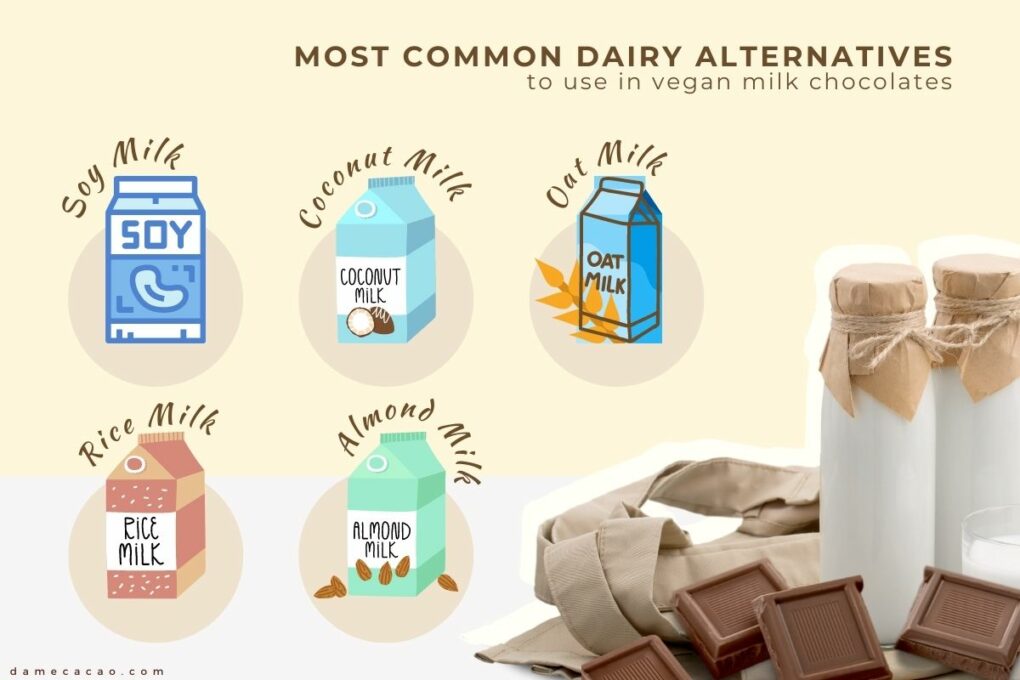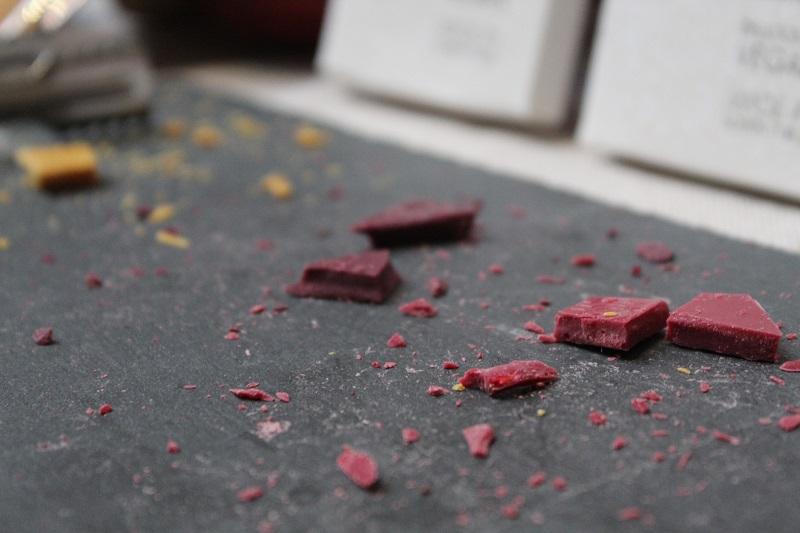When was the last time you had a little cocoa with your coconut? That's right, I'm talking mylk chocolates, a.k.a dairy free chocolates. Last spring, my podcast Chocolate On The Road dived into the topic of dairy free chocolate making, but more specifically, dairy-free milk chocolates.

While plant-based milks have been around for decades, it's only in the last 5 years or so that their popularity has skyrocketed, effecting demand in other food industries like chocolate. As discussed in the episode, this has come about for a multitude of reasons, the most notable being a better understanding of milk sensitivities and the increasing popularity of veganism.
Coconut milk chocolate has now become a standard part of any craft chocolate maker's offerings. Yet the list of plant-based milks being used in chocolate seems to grow every day. From grains & fruits to legumes & nuts, there's an option for every dietary requirement, all of which have less environmental impact than dairy.
Some of the best chocolate online is already dairy-free, but this wave of milk alternatives has hit the chocolate industry in a big way. A few large-scale chocolate manufacturers have even released vegan chocolate lines in light of this demand.
But the rise of milk alternatives has run into some legal labeling obstacles with the FDA and the dairy industry. So what does the continued rise of this movement mean for the future directions of the chocolate industry, and the planet as a whole?

Jump To
Best Dairy Free Chocolate Options
In addition to increasing popularity, milk alternatives have also expanded beyond the typical soy to include over a dozen variations of plant-based "mylks." Whether you're lactose intolerant or just choose to avoid animal products in general, your drinking options now abound.
Unfortunately, some of those options don't translate so well into industries like chocolate. This is because of the role which dairy milk powder in the chocolate itself. Mammal milk powder (cow, goat, etc.) has almost no moisture & a unique fat structure which affects flavor, tempering, and texture.
All of these are factors which a chocolate maker must take into account when formulating a new product. For example, one of the things milk powder does is soften the flavor of the cacao, which can be bitter and astringent, so anything with a strong taste wouldn't work well.
So while pea milk, hemp milk, flax milk, cashew milk, macadamia milk, pistachio milk, peanut milk, and walnut milk may be relatively common dairy milk alternatives, for variety of reasons, none of them are commonly used in the chocolate industry.
Therefore I won't really be addressing those (today), but rather the five main dairy alternatives in chocolate: coconut, oat, rice, soy, and almond milk. Plus a bonus category: fruit powders.

Coconut Milk Chocolate
Coconut milk makes for a sweet-smelling powder, created through the process of spray-drying raw, unsweetened coconut cream. Along with soy milk, it's one of the oldest dairy alternatives on the market, though it's still much more commonly used for cooking and in dairy-based treats like ice cream.
In South and Southeast Asia specifically, coconut milk is the base for many stews and curries (and increasingly, for sweets). The use of coconut milk in vegan milk chocolates dates back well over a decade, and it's one of the earliest powdered milk substitutes commercially available.
While its nutritional profile is fattier than whole milk powder (due to the presence of coconut oil), this just means that the chocolate requires less added cacao butter.
Otherwise, coconut milk is quite comparable and actually allows for a higher percentage of cocoa solids. Personally, I think coconut milk still makes the best dairy-free chocolate.
However, it does tend to add a sweet coconut flavor to the chocolate, sometimes making it feel more oily on the palate if too much is used in the recipe. Pure coconut milk chocolates are dairy-free, nut-free, and grain-free, but always check ingredients' lists to make sure.
My Coconut Milk Chocolate Recs: Charm School 49% Milk Chocolate, Chocolate Tree's 55% Coconut, and Marou Coconut Milk Ben Tre 55%.

Oat Milk Chocolate
Oat milk has quickly become the second-favorite option for makers looking to get into the dairy free chocolate game. The powder adds a slightly toasted cereal flavor and tends to have a stronger snap than a traditional milk chocolate.
Oat milk powder is actually made by spray-drying previously-prepared oat milk (which you can also make at home), which boasts a similar nutrition profile to dairy milk.
However, since plain oat milk has less fat but a similar sweetness level to cow's milk, oat milk chocolates require a fattier cacao bean or extra cocoa butter to compensate for the {oat} milk solids. Pure oat milk chocolate is gluten-free, nut-free, and dairy-free, but always check ingredients' lists to make sure.
My Oat Milk Chocolate Recs: Raaka 58% Oat Milk Chocolate (incl. coconut), Potomac's Oat Milk Chocolate, and Mike & Becky's 72% Andean Oat Mylk.

Rice Milk Chocolate
One of the newer entrants to the market, rice milk has taken a small portion of the dairy alternative market in chocolate. The rice powder generally used in chocolate making is a blend of dried rice starch, rice syrup, and rice flour, the latter of which is actually just a byproduct of polishing rice grains.
Because rice powder is so absorbent, there needs to be extra fat in the recipe to compensate, so rice milk chocolates are usually made with a higher percentage of cacao and less sugar.
One maker I know of has used toasted rice powder as a flavor element in one of her bars, but even in amounts as low as 10%, rice powder is drying & adds a punch of breakfast cereal flavor to an otherwise dark chocolate bar. Pure rice milk chocolate is gluten-free, nut-free, and dairy-free, but always check ingredients' lists to make sure.
My Rice Milk Chocolate Recs: Montezuma's Like No Udder.

Soy Milk Chocolate
Soy milk is made from the legume of the same name, and for many it's the original non-dairy milk. Soy milk powder is more recent in its popularity, and with such a multitude of other options, most chocolate makers are actually staying away from soy.
Not only does it add more of a nutty umami flavor than something like oats, but it's gotten a lot of bad press lately that's got consumers confused. Regardless of how you feel about it, however, soy is probably the most chemically similar to milk, meaning that the texture of the final product will most resemble a traditional dairy milk chocolate.
Unfortunately for soy, unless you're also a fan of its strong flavor, great texture will only get you so far. Note that pure soy milk chocolate is gluten-free, nut-free, and dairy-free, though always check ingredients' lists to make sure.
My Soy Milk Chocolate Recs: Solkiki's Costa Esmeraldas 49% and Zotter's 40% Soy Milk Chocolate.

Almond Milk Chocolate
Almond milk chocolate is still finding its footing. Some people would argue that adding any sort of nut to a chocolate recipe automatically makes it a chocolate-flavored nut butter. But the difference is in the type of almond product being added to the chocolate, as well as the much lower proportion of almonds.
Most almond mylk chocolates will actually contain an additional plant-based milk powder. Chocolate bars made with only almonds can add a sort of grainy, drying texture while it's melting and a harder snap when you break into them.
They've also caught a lot of flak recently for how much water is needed to produce almond milk relative to other plant-based alternatives (that increase remains true with almond milk powder). Pure almond milk chocolate is gluten-free and dairy-free, but always check ingredients' lists to make sure.
My Almond Milk Chocolate Recs: Artisan Du Chocolat 40% Almond Milk and Taza's Almond Classic (honorable mention Karuna Black Currant White Chocolate).

Fruit Powders In Chocolate
This is a bit of a bonus category in that fruit powders have more often been used as an alternative sweetener rather than an alternative milk. However, France-based Valrhona Chocolate has recently come out with their own line of fruit-based chocolates (linked above) which use freeze-dried fruit powders in place of milk, and only use the fat of the cocoa bean rather than the whole beans.
These dairy free fruit couvertures (as they've been dubbed) come in raspberry, strawberry, yuzu, and passion fruit, as well as an almond version which is (duh) not a fruit but still quite relevant as an almond milk white chocolate.
The final chocolate is dairy-free and gluten-free (& nut-free in the case of the fruit flavors), and each is a sweet-tart version of the fresh fruit itself, with no added vanilla to complicate the profile.
Why Reach For Dairy Free Chocolate?
Massive waves of societal change have contributed to demand for nondairy chocolates. Not everyone will enjoy dairy free chocolates, but for those with an open mind and a bit of spending money, well, the world is your oyster.
These days there are so many options that it's no longer considered a niche product. But as a consumer, why go for a vegan milk chocolate instead of a traditional one?
Well, the main considerations are threefold: 1) a desire to lessen dependence upon environmentally-impactful animal products; 2) increases in milk allergies and sensitivities; and 3) good old-fashioned curiosity about new & unique flavors.
I won't go into the nitty-gritty of how powdered milk is made and the horrors of the dairy industry; PETA does a good enough job of that on their own. But suffice it to say that powdered milk is much more impactful ounce-by-ounce than a glass of milk, and a plant-based option will always lower your carbon footprint.
Plant-based milks have their own allergen issues, but nowhere near the level that milk has reached globally. The truth is, adding anything in place of powdered milk will have an impact upon the flavor and texture of the final product.
Plant-based options will only be able to go so far, but even replacing half of the dairy consumed by the chocolate industry with plants would have huge long-term impact. After all, chocolate is originally a plant-based food, itself (cacao fruit + cane grass).

Are All Dairy Free Chocolates Vegan? (& Other FAQ)
This is where I answer all of your most common questions about dairy free chocolates, including whether they're all vegan (or not). The answer, by the way, is no— not all dairy-free chocolates are vegan friendly.
I went over this in my article on vegan chocolate, but to sum it up, unfortunately much of the non-organic cane sugar is processed with bone char. This means that even if a milk chocolate is only made with cacao nibs or cocoa powder, coconut, and sugar, it may still not qualify as vegan (unless the sugar is certified organic or certified vegan).
This is why most vegan chocolate recipes specify using vegan chocolate rather than simply dark or dairy free chocolate.
Why can't you use regular milk to make chocolate?
You can't use liquid milk to make chocolate because milk has a high water content, which would cause the chocolate to seize, meaning that it thickens unevenly and loses its smooth texture.
Powdered milk has been spray-dried to remove almost all moisture, so it blends easily into the heated unsweetened chocolate. This is also why you use powdered forms of plant-based milks rather than the liquid.
Why are nondairy milk chocolates not legally chocolate?
The legal definition of "milk chocolate" in both the EU and the US includes a minimum percentage of dairy milk in order for a product to legally call itself milk chocolate.
Since plant-based milks are obviously dairy-free, milk chocolates made with milk alternatives have to call themselves something other than "milk chocolate" (they could call it "mylk chocolate," for example).

What are the best dairy-free chocolates in the supermarket?
Beyond just choosing an organic dark chocolate, you can also find plant-based milk chocolates from Pascha Organics and Raaka Chocolate in many supermarkets in the USA. For ethically-sourced plain dark chocolates I'd recommend Alter Eco, Divine, and Equal Exchange.
Are vegan and dairy-free chocolate the same? Nope! "Vegan" is an all-encompassing term which means that a product is free of any animal products, including dairy. On the other hand, "dairy-free" only tells you that a product contains no mammalian milk (from cows, sheep, goats, etc.), but it could still contain honey or white sugar processed with bone char.
Here are some dairy ingredients you may not associate with dairy: whey (protein), casein (protein), curd (cheese), paneer (cheese), ghee (butter). Remember to always keep an eye out for allergen warning labels on packaging. At least in the US, manufacturers have been required to label the big 8 allergens on their packaging ever since the Food Allergen Labeling and Consumer Protection Act went into effect in 2006.
While this isn't relevant for some consumers, please keep in mind that US labelling laws only legally require companies to warn consumers if a product contains cow's milk (not any other mammal milk), so always read the ingredients list!

















Comments
No Comments